(RETURN)
SAIL VOLUME I
III TEA CLIPPERS
TAEPING
(1863-1871), 767 registered tons, length 183ft 7in, beam 31ft 1in,
depth 19ft 9in. Of
composite(iron frame
planked) construction, built by
Robert Steele, Greenock, for
Rodger
& Co. She was designed and built
to
be faster than FIERY
CROSS which had been the leading clipper with
the
new season tea from China in
1861 and 1862. In her maiden voyage in 1864,
she arrived too late
at the Pagoda anchorage to be among
the first ships
loaded with the new tea
from Foochow. In 1865,
damage she had received
in a typhoon
again prevented her form being among the first ships. In 1866,
she was among the first ships
and in
a tight race with ARIEL and SERICA -
all three docked on the same
tide in the Thames, 99days
out. She shared the
honours with ARIEL. In 1867,
Taeping was home a
week ahead of any other
tea
clipper after a passage of 103 days. But SIR LANCELOT which
arrived
later had made the passage in
99
days. In 1868, TAEPING, ARIEL and
SIR LANCELOT left the Pagoda
anchorage close together.
TAEPING was
beaten by SPINDRIFT, ARIEL
and SIR LANCELOT in a close finish. In
1869, all
records were broken by SIR LANCELOT's passage of 89 days and
THERMOPYLAE's 91 days.
In 1871, TAEPING was wrecked on Ladd'sReef
in the South China Seabound
from Amoy to New York.
Steamers took over
the tea trade from
1875.
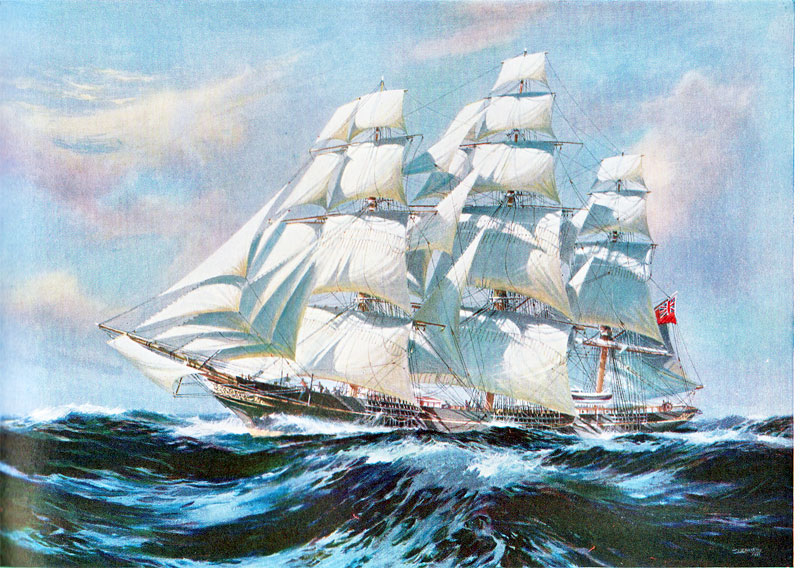
ARIEL (1865 -
1872), 886 tons register, length 197ft 4in, beam 33ft 7in, depth 21ft.
Of composite (iron frame
planked) construction, built by
Robert Steele, Greenock,
for Shaw, Maxton & Co.
Designed and
built for the tea trade, she was among the
leading ships in 1866 at the
Pagoda anchorage. The first four leading
ships away
were FIERY CROSS, ARIEL,
TAEPING and SERICA. As described above, the race
to London became a close
contest at the
end between TAEPING and ARIEL, who
with SERICA, all reached the
Thames on the same tide 99
days out. In 1867, ARIEL
was not in time to load among
the leading
ships. Eleven ships had departed
before
she got away but she
overhauled ten of them except the leader TAEPING. In 1868,
there was a
close finish with SPINDRIFT beating ARIEL, SIR LANCELOT and
TAEPING. 1n
1869, SIR LANCELOT and THERMOPYLAE broke all records
reaching the Thames 81 and 91
days out
respectively. ARIEL took 104 days. In
1870, becaus of a broken
topmast in a typhoon and repairs in
Yokohama meant
that she could not be at the
Pagoda anchorage in time.
She took instead a Japanese
charter to New York. In
January 1972, she left London for Sydney
and was listed as
missing and not
heard of again.

SIR LANCELOT
(1865 - 1895), tonnage 886 gross 865 net, length 197ft 6in,
beam 33ft
7in, depth 21ft. Of composite (iron frame
planked) construction,
built by Rbert Steele,
Greenock, for J. MacCunn.
A sister ship of ARIEL.
On her maiden voyage to China
in she was towed up the Yangtze to
Hankow
for a cargo of tea under
charter
with Jardine, Matheson & Co. On her second
voyage in 1867, she was
not in time to join the leaders at
Foochow but loaded
tea at Shanghai. There
were seveteen Foochow
and Shanghai ships ahead of
her
but she managed to overhaul all but TAEPING. Deal was made in 99
days
- the passage of the year.
in 1868, as described above, she was beaten by
SPINDRIFT and
ARIEL In 1869, she beat THERMOPYLAE
to London in a
record 81 day
passage. In 1870, she beat
Thermopylae again in the race
from
Foochow to London. In
1871 she took a cargo of tea from Shanghai to New
York. In
1872, her passage home from Foochow was 122 days and in 1873 from
Shanghai 127 days. Her
glory days were over. In 1876 she was reduced to a
barque. In
1895, she was sold to Persian
owners. In September, 1895, sailed
from Muscat bound for
Calcutta
but never arrived.
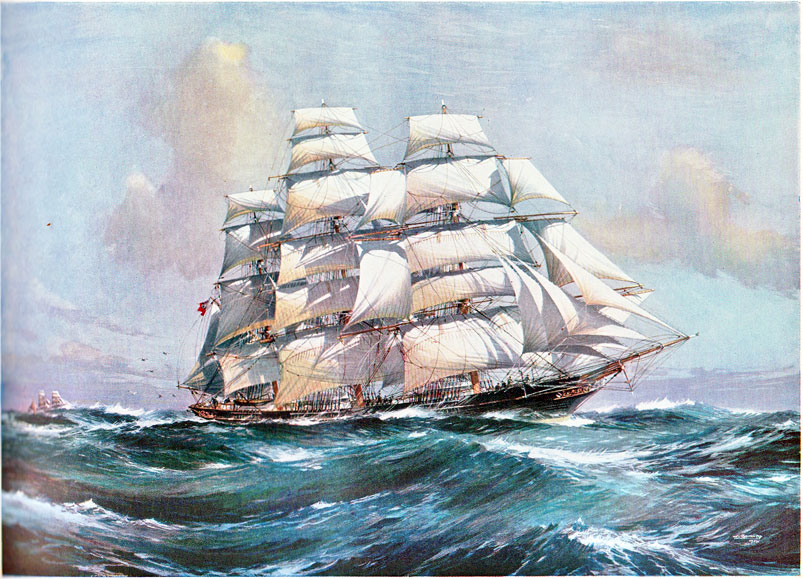
THERMOPYLAE (1868 -
1907), tonnage 991 gross and 948 net, length 210ft, beam 36ft,
depth21ft.
Of
composite (iron frame planked)
construction, designed by Bernard Waymouth (who had designed
LEANDER)
and built byHood, Aberdeen, for George Thompson
of the Aberdeen White Star Line.
On her
maiden voyage she went Melbourne in a record 62 days from the Lizard
and 63 days
from
Gravesend. She carried coal to Shanghai.and was in time to be a
lead ship at the Pagoda anchorage at
Foochow.
She departed
Foochow in July 1869 with her first tea
cargo and docked in London 91 days
out.
To her captain's
annoyance this was put in
the shade by SIR LANCELOT's later arrival 85 days out.
THERMOPYLAE made eleven tea passages
with an average passage
time of 106.5 days. She failed to
get
tea
cargoes in 1879 and
1880 and went to Sydney in both years and obtained wool cargoes.
Her
last
tea cargo
was in 1881. After that she carried wool
from Sydney up to 1890. She was sold in 1890 to
Canadian
Pacific
coast
owners and was in the trans Pacific trade. In 1895, she was
sold to Portuguese
Government for use as a training ship and was
renamed PEDRO NUNEZ. In 1907, she was ceremonially
towed out
of
the Tagus by the Portuguese naval vessels and torpedoed.
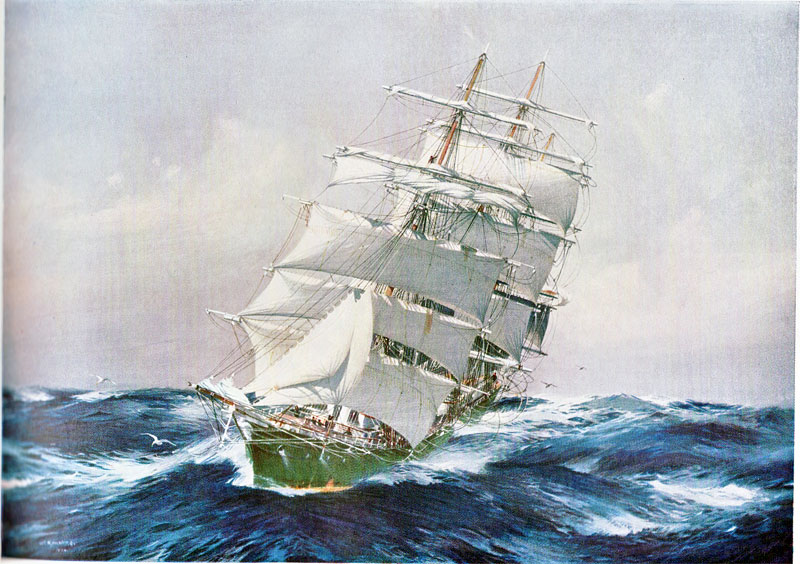
CUTTY SARK (1869 - 1954), tonnage
963 gross 921 net, length 212ft 5in, beam36 ft, depth21
feet.
Of composite (iron frame planked)
construction, built by Scott & Linton-Denny Bros, Dumbarton,
for
Captain
John ('White Hat') who wanted a tea
clipper to beat
THERMOPYLAE. Designed by
Hercules Linton
- there are arguments about the influence of the design
and sail
plan of
theTWEED which
was Willis'
favourite ship.
Scott & Linton was bankrupted before construction was completed.
With the
support of
the
creditors, Denny Bros completed the ship. The result was.a
vessel more powerful than
any
of the other
tea clippers -
maybe
not as
fast as THERMOPYLAE in light airs but faster in stronger winds.
The CUTTY
SARK's made eight voyages to
China from 1870 to
1877 - four to Shanghai and
four to
Hankow where
she was
towed up and back on the Yangtze - for tea
cargoes. After 1877 she was
unsuccessful in
getting tea
cargoes
and carried jute
from Manila to New York and othercargoes. Only
in
1872, when she
and THERMOPYLAE left
Shanghai within few hours of
each other was there the
opportunity of
a test
between the two vessels. They reached and passed through the
Sunda Straits close
together and
separated from there. The CUTTY SARK
lost
her rudder in a heavy gale some 400 nautical
miles from the
Cape of
Good Hope and it
took six days under difficult
condions for the cew to rig a jury
rudder.
She reached London 122 days out a week after
THERMOPYLAE.
In 1883, CUTTY
SARK
entered the
Australian wool
trade. In twelve voyages she established her superioruity over other
vessels.
1n eight return
voyages from Sydney she reached Ushant
in 1885 in 67 days, the Downs in1887 in 73
days, London in
1889
in 86 days,
London in 1890 in 75 days, London in1891 in 93 days,
the Lizrd in
1892 in83
days, Bishops in 1993 in 90 days and
the Scillies in
1894 in 87 days. In 1895, she was sold to
Potuguese
ownere and was renamed FERREIRA. She traded between
Portugal and Rio de
Janiero, New
Orleans,
Mozambique, Angola and Britain. In May,
1916, she was dimasted off the Capeof Good Hope,
towed to
Capetown and re-rigged as a barquentine. In 1922, she
spotted in Falmouth by a former
windjammer
captain, Wifred
Dowman, who was successful in purchasing her. Sh e
was brought ot
Falmouth
re-rigged to an approximation
of her original rig, and used as a cadet training ship. After
Dowman's
death in 1936, she was purchased by the Thames Nautical
Training College, Greenhithe, the
move to
the Thames was her last use
of sail. In 1954 she was moved to a custom buit
dry-dock at
Greenwich.
After restoration she was opened to public
exhibition. badly damaged in a fire in 2007, she
has been
restored and is again open for exhibition under the care of the Cutty
Sark Trust.
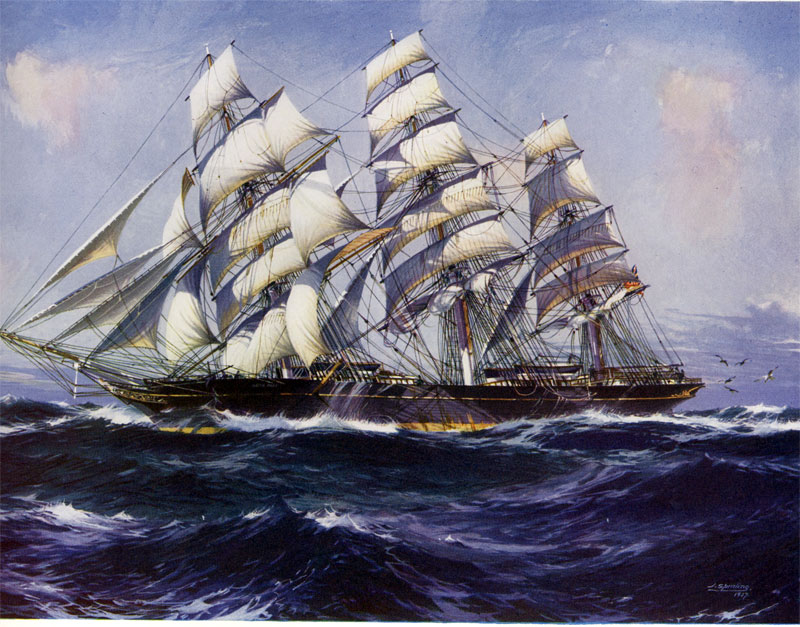
BLACKADDER (1870 - 1905), tonnage
970 gross and 918 net, length 216ft 6in, beam 35ft 2in,
depth 20ft 5in.
Constructed of iron, designed
on the lines of the TWEED and built by Maudsley
London (marine
engineers rather than builders) for Captai John ('White Hat')
Willis. Mistakes were
made in
fitting the masts. She
was in collisions and dismasted on her maiden voyage. On
her second
voyage in 1872,
she reached Shanghai in 95 days and returned from
Foochow in121 days. In 1873
she was
dismasted in a
typhoon off the Ladrones.on her way to Shanghai with a cargo of coal
from
Sydney. After
repairs at Shanghai she picked up a
cargo sugar at Ilo Ilo in the Philippines for Boston,
There was a
strsnding but the ship came off, and a long voyage in which supplies
of food ran out and
the crew arrived
in Boston suffering from scurvy.
The ship's luck appeared to change after this. Her
voyages to
China for tea in 1875, 1876 and 1877 were successful but in 1878
she, like others, was
unable to obtain
a cargo of tea but found
a cargo in Calcutta . In 1880, she was again successful in
getting a
cargo of tea. In a race home with her sister ship HALLOWEEN from
Foochow, she reacxhed
London 130 days
out and her sister reached
Deal 126 days out. In 1881 in Shaghai she
loaded a part
tea cargo for
New York. In 1882, she brought back a
cargof sugar from Java. In 1886/87 and
1887/88, she was
carring wool from Newcastle, N.S.W.. In the nineties she was carrying
wool from
Brisbane. and
made good passages home of
under 90 days. .In 1900, she was sold to Norwegin
owners. She was
wrecked in November 1905 in a voyage from Barry to
Bahia with a cargo of coal.
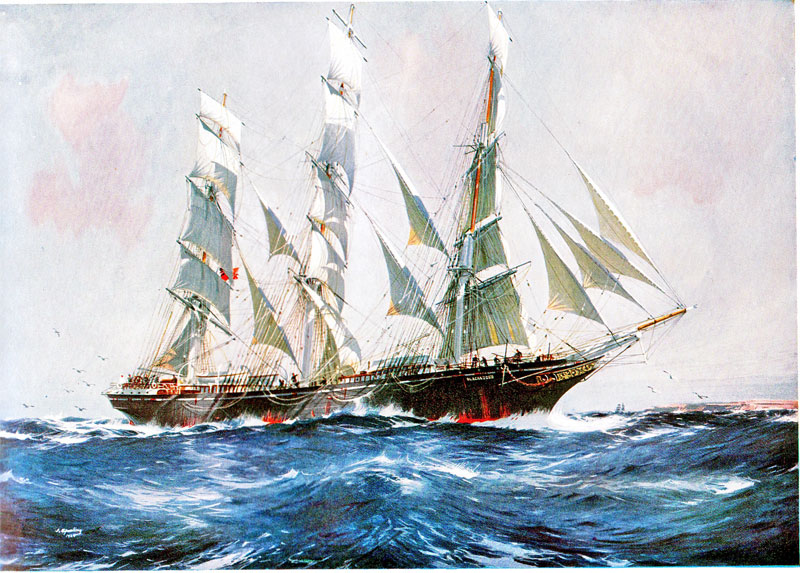
(RETURN)





